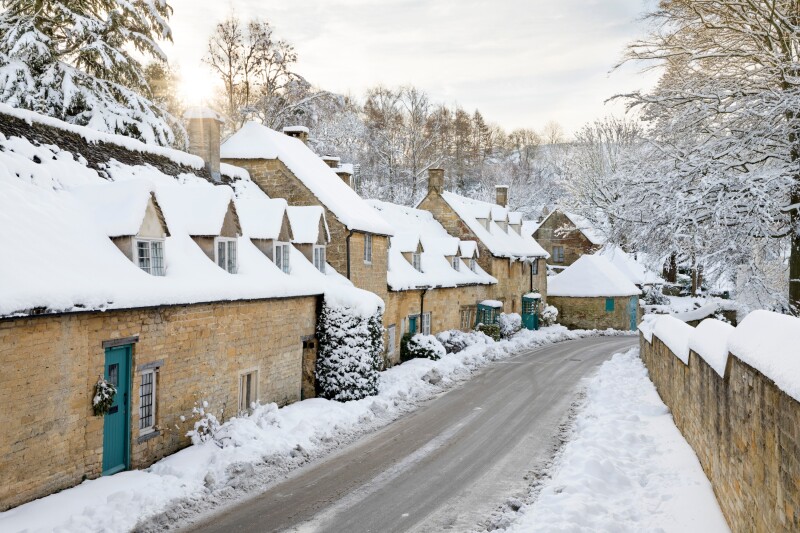Europe’s quintessential summertime locales (Greece! Croatia! Sicily!) need no introduction, although they do come with the sobering realities of overcrowding, increasingly common heat waves, and through-the-roof hotel rates in the warmer months.
Instead, consider an off-season visit to these popular destinations. Winters in these seven places translate to cooler, comfortable temps, a bit of holiday season cheer—and maybe even a new perspective on the best destinations for a winter vacation.
1. Dubrovnik, Croatia
There’s a good reason Dubrovnik is billed as the “pearl” of the Adriatic. Its coastal location, well-preserved medieval architecture, and numerous cultural attractions gave it UNESCO World Heritage status. Mild temperatures and lovely holiday festivity make the city an ideal candidate for off-season travelers. In December, the Old Town feels magical and intimate with Christmas markets and outdoor concerts. Be sure to sample orahnjaca, a traditional walnut roll cake.
There are plenty of year-round activities visitors can also check out. Walk the old city walls (and stop for the jaw-dropping view from Minčeta Fortress) and visit Rector’s Palace, which now houses the Cultural History Museum.

As the summer crowds finally thin, Provence, like many of its south of France neighbors, takes on a refreshingly slower pace.
Photo by FiledIMAGE/Shutterstock
2. Provence, France
While the Provence’s famed grape vines, olive groves, and lavender fields go dormant in the colder months, the countryside goes into peak truffle season during the late fall and winter. Hunt for the delicacy on a foraging tour with Les Pastras and visit busy markets overflowing with all manner of local goodies, including seasonal fruit, nougat, honey, and olive oil. There’s plenty of history to take in, too—the Romans saw the region’s trading and wine production potential long ago and many ancient Roman ruins still stand today. Avignon’s Gothic Pope’s Palace, Arles’s UNESCO-designated arena, and Nimes’s Pont du Gard are all easy day trips from the delightful town of Aix-en-Provence.

Sa Sartiglia is the traditional carnival of Oristano.
Photo by Marco Cuccu/Shutterstock
3. Sardinia, Italy
This 9,305-square-mile island in the middle of the Mediterranean Sea exemplifies la dolce vita, island style. Come for the powdery beaches, clear turquoise waters, and natural wonders (including several sea caves like Neptune’s Grotto), and fall in love with the appealing villages, ancient ruins, and delicious local cuisine. Several towns across the island—Nuoro, Oristano, Mamoiada, and Ottana—celebrate Carnival in February, with their own colorful iteration of masqueraded parades.

The colder months are a great time to explore Madeira’s natural wonders.
Photo by Robert Harding Video/Shutterstock
4. Madeira, Portugal
Many travelers come to Madeira just to walk: The island’s network of centuries-old levadas, or irrigation channels, have created some 1,800 miles of walking trails, much of them through verdant forests and along rugged, dramatic cliffs. Walking about town, in Funchal, is also a worthy pursuit with beloved cookie factories (Fábrica Santo António) and wine shops (legend goes that the signing of the Declaration of Independence was toasted with Madeira wine) lining the streets. The Madeira photography museum is also a must-visit, as is Bordal, one of a few remaining embroidery houses where you can see artisans at work.
January also marks a time of local traditions and festivities, including Festa de São Sebastião, which honors Saint Sebastian, the patron saint of Funchal. Join in on the lively mix of religious processions, local music, and traditional dances. Finish with dinner at Kampo, helmed by inventive chef Júlio Pereira.

Live out your winter wonderland dreams in the Cotswolds.
Photo by Robert Harding Video/Shutterstock
5. Cotswolds, United Kingdom
Enjoy warm cups of tea while cozying up in the Cotswolds, a region two hours west of London. Its rolling hills are briefly interrupted every now and then by a pint-size village with stone-clad and thatched roof cottage, and during the winter, travelers can stroll in snow-covered landscapes in small towns like the idyllic Bourton-on-the-Water. For a few nights between November 22 to December 30, 2024, grand castle Sudeley, a Tudor jewel dating back to 1442, will host a Spectacle of Light after-dark event, which invites visitors to walk an illuminated trail that follows the story of Sleeping Beauty.

Explore Timanfaya National Park in Lanzarote for incredible landscapes.
Photo by Robert Harding Video/Shutterstock
6. Lanzarote, Spain
The easternmost of the Canary Islands, Lanzarote has a volcanic landscape—lava flows, ash fields, hidden caves, and craters—that visitors can still explore during winter. While temperatures remain in the 60° to 70°F range, check out Timanfaya National Park, which showcases many of these features with unique rock formations and swaths of burnt orange–colored earth at every turn. It’s the volcanic eruptions responsible for forming the island that eventually created secluded sandy stretches and blue-green coves such as Papagayo beach. The island is also a fine place for scuba diving even during the colder months, giving you the chance to see angel sharks, octopus, and rays without the crowds.

Cities like Heraklion remain lively in the winter.
Photo by hybbGO/Shutterstock
7. Crete, Greece
The largest of the Greek islands is well-known for pink-sand beaches, agrotourism, and ancient Minoan ruins. Although numerous ferries operate year-round from Athens, the 50-minute flight from the capital to Heraklion is both easy and cheap. Once there, the major port towns of Chania, Rethmyno, and Heraklion—all along the northern coast—are where much of the action is concentrated. (And most restaurants, bars, and hotels don’t close in the off season, unlike in some of the smaller cities on Greece’s other islands.)
Tour sites such as the Knossos Palace, the second most visited archeological complex in Greece after the Acropolis and stop by olive oil farms like Cretan Olive Oil Farm (harvest season is from mid-November to January). Or stroll Elafonisi Beach, on the island’s southwestern coast, and explore the cobblestone lanes and alleys of the harbor towns.











